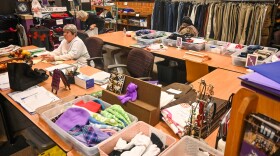Volunteers are packing up meals in the production hall at the Northern Illinois Food Bank — about an hour west of Chicago.
The majority of food banks across the country, including this one, report increased demand. In 2022, 13% of U.S. families said that they were food insecure at some point in the year.
“Right now we're working really hard on our holiday meal box program, getting about 50,000 traditional holiday meals out our food pantries,” said Jacob Lamplough, the food bank’s interim director of food procurement and donor development manager.
Over the past few years, the Northern Illinois Food Bank has been able to provide a lot more local produce to residents. They’ve received 400,000 pounds of food that otherwise would have nowhere to go.
“The peaches are the big one, we've had apples, and then we've even had things like squash and a bunch of different peppers,” he said.
That additional food has all been through Farm to Food Bank, a federally-funded program that’s currently in 28 states, including Illinois. It focuses on food farmers can’t sell to supermarkets because it has a blemish, a weird shape or just isn’t the right size. Before the program, such food often rotted away on farms, because there was no market for them.

How Farm to Food Bank works
Authorized through the 2018 farm bill, the Farm to Food Bank program has moved millions of pounds of surplus food. Last year, the U.S. Department of Agriculture handed out more than $7 million to state agencies for Farm to Food Bank projects, including in Illinois, Indiana, Iowa, Missouri and Michigan.
Stacy Dean, deputy under secretary for the USDA’s Food, Nutrition, & Consumer Services, said they still hope to spark interest in states that aren’t participating, such as Kansas, Nebraska and Oklahoma.
“These are the bread baskets of our country,” said Dean. “And if they're leaving food available, unharvested, that we can be using to feed vulnerable families, then let's work together to figure out a path forward.”

The Farm to Food Bank program is funded through the farm bill, which comes up for reauthorization every five years. Deans said, this fall, funding briefly expired before the farm bill was extended for another year.
“I think Farm to Food Bank was particularly vulnerable,” she said.
And funding in the next farm bill isn’t guaranteed.
Why Illinois is taking it a step further
In Illinois, officials wanted stability for the program. So, earlier this year Gov. J.B. Pritzker signed a law establishing a state-funded Farm to Food Bank initiative. That makes Illinois pretty unique among states who’ve utilized it.
Raghela Scavuzzo is the associate director of food systems development at the Illinois Farm Bureau. She said the state funding means the program will continue no matter what happens with the farm bill.

And she said that allows farmers to feel more stable and diversify their products.
“So maybe we were afraid to grow broccoli, because we didn't know the market was there. What happens if we can't move all of that or it's just not as pretty? Now we've created the secondary market to recover some of those potential losses,” she said.
While farmers aren’t paid full-price for the food, they’re able to cover their costs including labor and transportation. And they don’t have to see their food go to waste.
“We had a farm last week that was going to get hit by the frost with apples,” said Scavuzzo. “We moved almost 10,000 pounds of apples off of their trees. It covered their labor, but that product would have just had nowhere to go if it hadn't been for this project.”
It’s not that farmers didn’t want to donate this food before Farm to Food Bank — Scavuzzo said there were just barriers in the way of getting it onto people’s plates.
She said if they can secure both federal and state support for the program, it’s a bonus. That means Farm to Food Bank can reach more farms and branch out further into other areas like protein and dairy.
What it looks like at the farm
Rendleman Orchards is one of more than a dozen farms participating in Illinois’ program.
Wayne Sirles is the owner and manager of the orchards in far southern Illinois. He said, unfortunately, there are some fruits and vegetables that are more likely to go to waste.
“Very little processing takes place with zucchini or yellow squash as far as a secondary market for misshapen ones or blemished ones,” he said. “A lot of times that produce could possibly get dumped.”
Sirles says he’s in regular contact with Feeding Illinois — the nonprofit that administered the federally-funded version of the program — about how much surplus he has and what the food banks need.
He collects food from five or six farms to make up a semi load that he can truck to warehouses and drop-off locations. With the help of those local farms, they sent out about a dozen semi truck-loads of produce this year.
“It's a win win situation, not just for the customers of the food bank, but also for the farmers themselves,” Sirles said.
Peter Medlinis a reporter at WNIJ. This story was produced in partnership with Harvest Public Media, a collaboration of public media newsrooms in the Midwest. It reports on food systems, agriculture and rural issues.
Copyright 2023 KCUR 89.3. To see more, visit KCUR 89.3. 9(MDA4OTAxNzAzMDEzMjc0MTc2MzA5ZDZlMw004))







